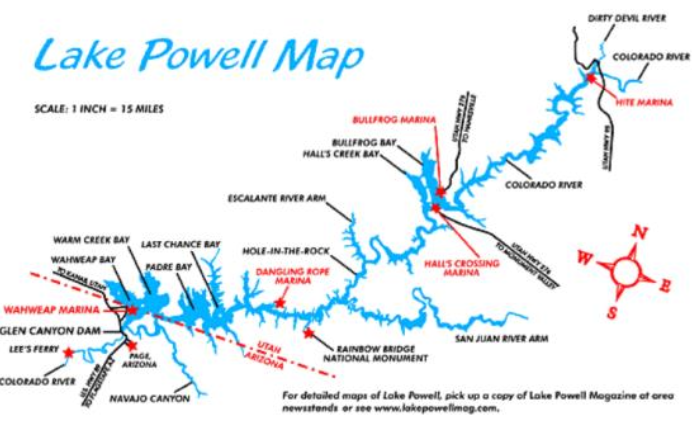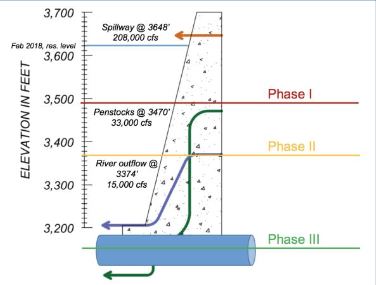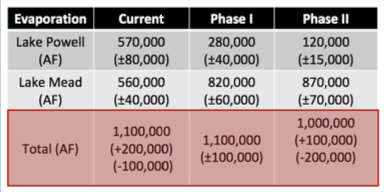UC Davis Ecogeomorphology Feb 28, 2018
Takeaway: The Glen Canyon Institute estimates that the implementation of the Fill Lake Mead First (FLMF) Initiative would save 300,000-600,000 acre feet (AF) of water per year, promote ecological recovery of Glen Canyon and restore the Colorado River to pre-dam flow and sediment regimes. Mr. Carey concluded in his presentation that based on the uncertainty and variation of evaporation and seepage rates, the best estimates of water savings via the FLMF Initiative are closer to 150,000 AF/year. River flow and sediment regimes would only be restored if the Phase III is implemented, and this is the most expensive and complicated Phase. A major point of disagreement in these numbers is a result of variable estimates in seepage rates. Therefore, it is recommended that additional research funds be focused on obtaining accurate estimates of seepage rates in Lake Powell before implementing or abandoning the FLMF Initiative. Additionally, based on the limited predicted benefits and potential loss of power generation via penstock outflow, Phases I & II should not be implemented until plans have been secured for Phase III.
Background: Lake Powell is the second largest reservoir in the United States and the Glen Canyon Dam, which lies below Lake Powell, acts as the divider between the upper and lower basins of the Colorado River (Fig.1). It serves as an important water storage facility as well as a source of power for the Western U.S. (4 billion kw hours). Scientists have observed a severe reduction in water levels within the Lake Mead and Lake Powell reservoirs, and it is estimated that these levels will continue to decline as we face hotter, drier conditions in the coming years. The primary objectives of the FLMF Initiative, proposed by the Glen Canyon Institute in 2013, suggested resource managers drain water from Lake Powell to fill Lake Mead, consolidating the Colorado River reservoirs in order to:
- Preserve water (estimated 300,000- 600,000 AF/year savings)
- Promote recovery of Glen Canyon
-
Restore the Colorado River to pre-dam flows.

Proposed Implementation of FLMF Initiative
The dam can spill ~208,000 cubic ft. per second (cfs) once it reaches the spillway. Additionally, it can release ~33,000 cfs through the penstocks (power generators) and ~15,000 cfs via river outflow (Fig.2). The FLMF Initiative is characterized by three phases:
Phase I: Lower water to 3,490’. This is just above the penstocks and is therefore the minimum level at which managers could maintain power production. This reduces outflows to ~48,000 cfs
Phase II: Lower water level to 3,370’. This would only allow the release of 15,000cfs via river outflow and would not allow any power to be produced via the penstocks.
Phase III: Build diversion tunnels around the dam to accommodate typical annual flows.

How much water is actually lost due to seepage and evaporation?
Evaporation is difficult to measure and has significant year-to-year variation. Estimated annual evaporation rates for Lake Powell and Lake Mead are 5.7 ft/year and 6.2 ft./year respectively. Based on estimates from Schmidt et al (2016) we may see a reduction from 1.1 million AF to 1 million AF as a result of filling Lake Mead first, saving us 100,000 acre feet of water (Fig. 3). With all the variation in evaporation however, it is difficult to say whether this initiative will actually save water in the long-run.
Though the sandstone beneath Lake Powell is believed to be more porous than the volcanic rock beneath Lake Mead, numerous studies have shown that the sandstone became saturated shortly after the development of the reservoir and that today ~50,000 acre feet of water is lost due to seepage into surrounding water table that could be prevented via the FLMF Initiative.
This means that an estimated total of ~150,000 AF of water is lost as a result of evaporation and seepage from Lake Powell each year

Is it possible to restore Glen Canyon and the Colorado river to pre-dam flow and sediment regimes?
Neither Phase I nor Phase II are capable of restoring Glen Canyon or the Colorado river to pre-dam flow and sediment regimes. Both outcomes are heavily reliant on the costly water and sediment diversion tunnels implemented in Phase III (see 1978 USBR report). Without the tunnels, the outflow rates cannot match the inflow rates and the two reservoirs cannot be consolidated. The primary concern with the FLMF Initiative during Phase I & II is that sediment will be remobilized during the water drawdown efforts and redeposited upstream from the dam in Glen Canyon. It is only after Phase III and the decades following its implementation that sediment will be restored to the entirety of the Grand Canyon.
This policy brief was composed on March 4, 2018
Sophie Preckler Quisquater
Political Aid to the U.S. representative for Kane County, Utah (mock aid).
